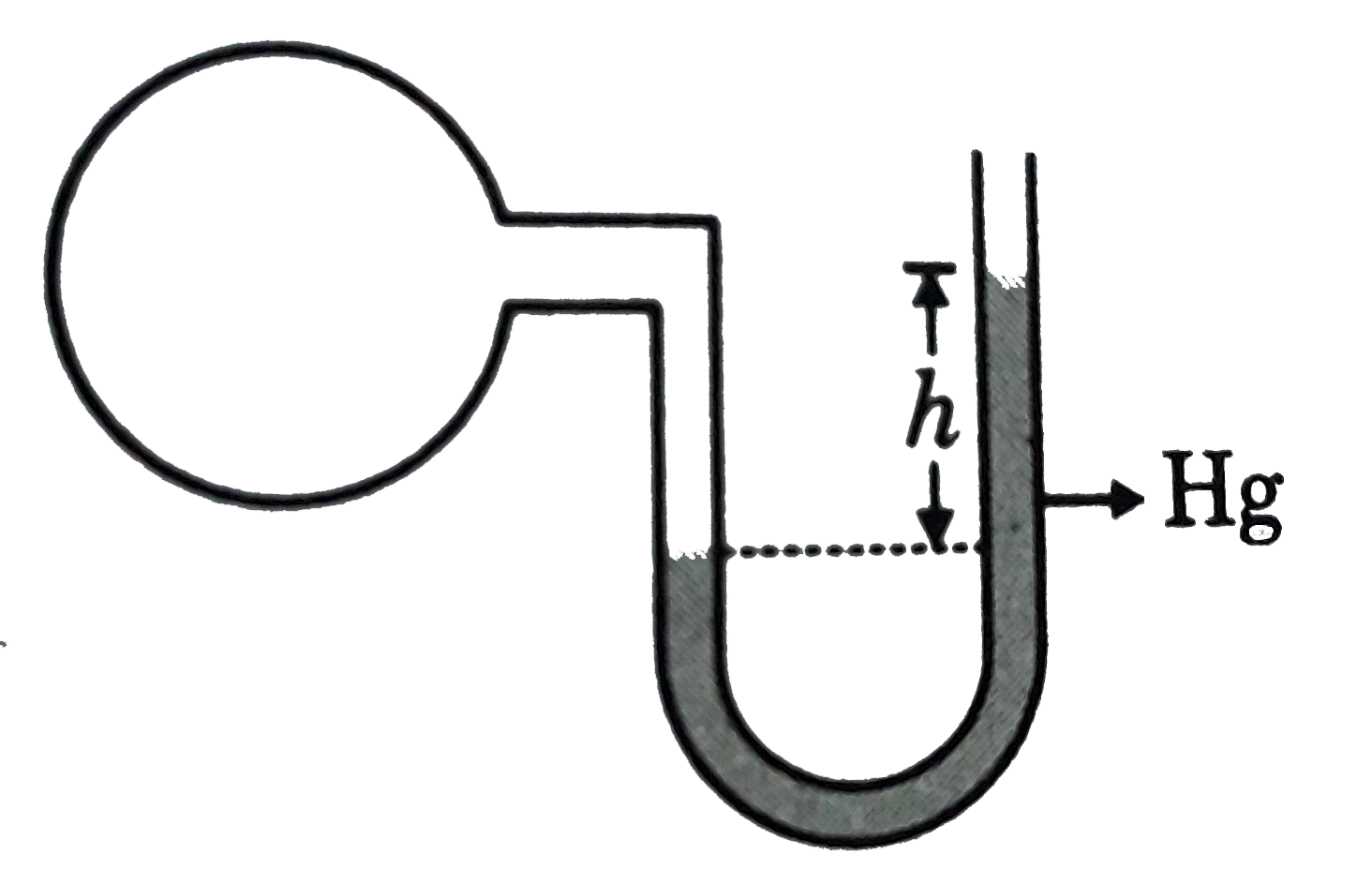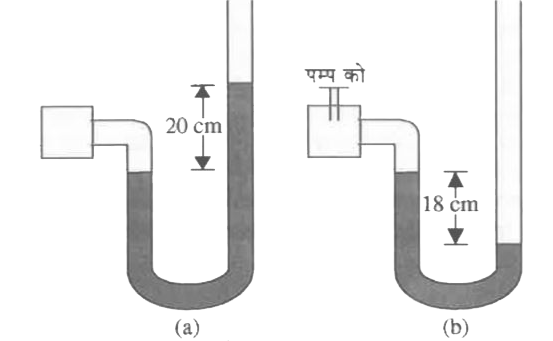A bulb of constant volume is attached to a very thin manometer tube as shown in figure. Gas starts leaking through a small hole in the bulb causing change in pressure as :
dpdt=−kP2

When k is constant and P is pressure at any instant
Initial height difference 'h' was 76 cm and after 10 mm 'h' was 38 cm.
The correct Answer is:1
Step by step video, text & image solution for A bulb of constant volume is attached to a very thin manometer tube as shown in figure. Gas starts leaking through a small hole in the bulb causing change in pressure as : (dp)/(dt)=-kP^(2) When k is constant and P is pressure at any instant Initial height difference 'h' was 76 cm and after 10 mm 'h' was 38 cm. by Chemistry experts to help you in doubts & scoring excellent marks in Class 11 exams.
Updated on:21/07/2023Topper's Solved these Questions
Similar Questions
For the reaction CO(g)+H2O(g)⇔CO2(g)+H2(g) at a given temperature the equilibrium amount of CO2(g) can be increased by :
View SolutionTotal nubler of mono chlorodervatives obrained by replacement of H by Cl in propene are :
View SolutionA manometer is connected to a gas containing bulb. The open arm reads 43.7cm whereas the arm connected to the bulb reads 15.6cm. If the barometric pressure is 743mm mercury , calculate the pressure of the gas in bar?
Strategy : The pressure of the gas inside the bulb is greater than the external atmospheric pressure because the height of mercury column in the left arm is less than in the right arm.Therefore ,
pgas(in cm)=patom(in cm)+hcm
View SolutionThe pressure of a gas filled in the bulb of constant volume gas thermometer at 0^(@)C and 100^(@)C are 28.6 cm and 36.6 cm of mercury respectively. The temperature of bulb at which pressure will be 35.0 cm of mercury will be
View SolutionA bulb of constant volume is attached to a manometer tube open at other end as shown in figure. The manometer is filled with a liquid of density (1//3)^("rd") that of mercury. Initially h was 228 cm. Through a small hole in the bulb gas leaked assuming pressure decreases as (dP)/(dt)=-kp. If value of h is 114 cm after 14 minutes, what is the value of k (in "hour"^(-1) )? [ Use : In (4/3) =0.28 and density of Hg =13.6 g/mL.].
View SolutionA manometer reads the pressure of a gas in an enclosure as shown in the figure. The absolute and gauge pressure of the gas in cm of mercury is (take atmospheric pressure =76 cm of mercury)
View Solutionचित्र (a) में दर्शाए अनुसार कोई मैनोमीटर किसी बर्तन में भरी गैस के दाब का पाठ्यांक लेता है। पंप द्वारा कुछ गैस बाहर निकालने के पश्चात मैनोमीटर चित्र (b) में दर्शाए अनुसार पाठ्यांक लेता है। मैनोमीटर में पारा भरा है तथा वायुमंडलीय दाब का मान 76 cm (Hg) है।
(i) प्रकरणो (a) तथा (b) में बर्तन में भरी गैस के निरपेक्ष दाब तथा प्रमापी दाब cm (Hg) के मात्रक में लिखिए।
(ii) यदि मैनोमीटर की दाहिनी भुजा में 13.6 cm ऊँचाई तक जल (पारे के साथ अमिश्रणीय ) उड़ेल दिया जाए तो प्रकरण (b) में स्तर में क्या परिवर्तन होगा? (गैस के आयतन में हुए थोड़े परिवर्तन की उपेक्षा कीजिए। )

View SolutionA bulb filled with a gas is connected to an open -end manometer. the level of mercury in the arm attached to the gas bulb is 20 cm lower than that in the open. end arm, calculate the pressure of the gas in the bulb in the units of atm and Pa? Consider the atmospheric pressure to be 76 cm Hg.
View Solutionचित्र (a) में दर्शाए अनुसार कोई मैनोमीटर किसी बर्तन में भरी गैस के दाब का पाठ्यांक लेता है | पंप द्वारा कुछ गैस बाहर निकालने के पश्चात मैनोमीटर चित्र (b ) में दर्शाए अनुसार पाठ्यांक लेता है | मैनोमीटर में पारा भरा है तथा वायुमंडलीय दाब का मान76 cm (Hg) है |
प्रकरणों(a) तथा (b) में बर्तन में भरी गैस के निरपेक्ष दाब तथा प्रमापी दाब cm(Hg) के मात्रक में लिखिए |
View Solutionएकसमान आयतन के दो काँच के बल्बों को एक छोटी नली द्वारा जोड़कर उनमे 0∘Cऔर 76 सेमी पारे के दाब पर एक गैस नहरी गई। अब एक बल्ब 62∘C पर गरम किये गए एक जल ऊष्मक में रखा गया। यदि जोड़ने वाली नली का आयतन नगण्य हो , तो बल्ब में नया दाब क्या होगा ?
View Solutionचित्र (a) में दर्शाए अनुसार कोई मैनोमीटर किसी बर्तन में भरी गैस के दाब का पाठ्यांक लेता है। पंप द्वारा कुछ गैस बाहर निकालने के पश्चात मैनोमीटर चित्र (b) में दर्शाए अनुसार पाठ्यांक लेता है। मैनोमीटर में पारा भरा है तथा वायुमंडलीय दाब का मान 76 cm (Hg) है।
(i) प्रकरणो (a) तथा (b) में बर्तन में भरी गैस के निरपेक्ष दाब तथा प्रमापी दाब cm (Hg) के मात्रक में लिखिए।
(ii) यदि मैनोमीटर की दाहिनी भुजा में 13.6 cm ऊँचाई तक जल (पारे के साथ अमिश्रणीय ) उड़ेल दिया जाए तो प्रकरण (b) में स्तर में क्या परिवर्तन होगा? (गैस के आयतन में हुए थोड़े परिवर्तन की उपेक्षा कीजिए। )

View SolutionA manometer reads the pressure of a gas in an enclosure as shown in figure (a) When a pump removes some of the gas , the manometer reads as in figure (b). The liquid used in the manometers is mercury and the atmospheric pressure is 76 cm of mercury.
(a) Give the absolute and gauge pressure of the gas in the enclosure for cases (a) and (b) , in units of cm of mercury.
(b) How would the levels change in case (b) if 13.6 cm of water (immiscible with mercury) are poured into the right limb of the manometer ? (Ignore the small change in the volume of the gas).

View SolutionA bulb of constant volume is attached to a manometer tube open at other end as shown in figure. The manometer is filled with a liquid of density (1//3)^("rd") that of mercury. Initially h was 228 cm. Through a small hole in the bulb gas leaked assuming pressure decreases as (dP)/(dt)=-kp. If value of h is 114 cm after 14 minutes, what is the value of k (in "hour"^(-1) )? [ Use : In (4/3) =0.28 and density of Hg =13.6 g/mL.].
View SolutionThe pressure of a gas filled in the bulb of a constant volume gas thermometer at 0∘Cand100∘C 28.6 cm and 36.6 cm of mercury respectively. The temperature of bulb at which pressure will be 35.0 cm of mercury will be
View SolutionA manometer reads the pressure of a gas in an enclosure as shown in the figure. The absolute and gauge pressure of the gas in cm of mercury is (take atmospheric pressure =76 cm of mercury)
View Solution
